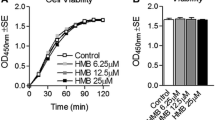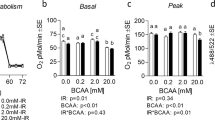Abstract
Leucine has been largely implicated for increasing muscle protein synthesis in addition to stimulating mitochondrial biosynthesis. Limited evidence is currently available on the effects and potential benefits of leucine treatment on skeletal muscle cell glycolytic and oxidative metabolism. This work identified the effects of leucine treatment on oxidative and glycolytic metabolism as well as metabolic rate of human and murine skeletal muscle cells. Human rhabdomyosarcoma cells (RD) and mouse myoblast cells (C2C12) were treated with leucine at either 100 or 500 μM for 24 or 48 h. Glycolytic metabolism was quantified by measuring extracellular acidification rate (ECAR) and oxidative metabolism was quantified by measuring oxygen consumption rate. Peroxisome proliferator-activated receptor coactivator 1 alpha (PGC-1α), an important stimulator of mitochondrial biosynthesis, was quantified using flow cytometry and verified by immunofluorescent confocal microscopy. Mitochondrial content was quantified using mitochondrial and cytochrome C staining measured by flow cytometry and confirmed with confocal microscopy. Treatment with leucine significantly increased both basal and peak oxidative metabolism in both cell models. Leucine treated cells also exhibited significantly greater mitochondrial proton leak, which is associated with heightened energy expenditure. Basal ECAR was significantly reduced in both cell models following leucine treatment, evidence of reduced lactate export and more complete carbohydrate oxidation. In addition, both PGC-1α and cytochrome C expression were significantly elevated in addition to mitochondrial content following 48 h of leucine treatment. Our observations demonstrated few dose-dependent responses induced by leucine; however, leucine treatment did induce a significant dose-dependent expression of PGC-1α in both cell models. Interestingly, C2C12 cells treated with leucine exhibited dose-dependently reduced ATP content, while RD ATP content remain unchanged. Leucine presents a potent dietary constituent with low lethality with numerous beneficial effects for increasing oxidative preference and capacity in skeletal muscle. Our observations demonstrate that leucine can enhance oxidative capacity and carbohydrate oxidation efficiency, as well as verify previous observations of increased mitochondrial content.










Similar content being viewed by others
References
Araki M, Maeda M, Motojima K (2012) Hydrophobic statins induce autophagy and cell death in human rhabdomyosarcoma cells by depleting geranylgeranyl diphosphate. Eur J Pharmacol 674:95–103
Armoni M, Quon MJ, Maor G, Avigad S, Shapiro DN, Harel C, Esposito D, Goshen Y, Yaniv I, Karnieli E (2002) PAX3/Forkhead homolog in rhabdomyosarcoma oncoprotein activates glucose transporter 4 gene expression in vivo and in vitro. J Clin Endocrinol Metab 87:5312–5324
Atherton PJ, Smith K, Etheridge T, Rankin D, Rennie MJ (2010) Distinct anabolic signalling responses to amino acids in C2C12 skeletal muscle cells. Amino Acids 38:1533–1539
Bruckbauer A, Zemel MB (2011) Effects of dairy consumption on SIRT1 and mitochondrial biogenesis in adipocytes and muscle cells. Nutr Metab 8:91
Deldicque L, Canedo CS, Horman S, De Potter I, Bertrand L, Hue L, Francaux M (2008) Antagonistic effects of leucine and glutamine on the mTOR pathway in myogenic C2C12 cells. Amino Acids 35:147–155
Du M, Shen QW, Zhu MJ, Ford SP (2007) Leucine stimulates mammalian target of rapamycin signaling in C2C12 myoblasts in part through inhibition of adenosine monophosphate-activated protein kinase. J Anim Sci 85:919–927
Giulivi C, Ross-Inta C, Horton AA, Luckhart S (2008) Metabolic pathways in Anopheles stephensi mitochondria. Biochem J 415:309–316
Glynn EL, Fry CS, Drummond MJ, Timmerman KL, Dhanani S, Volpi E, Rasmussen BB (2010) Excess leucine intake enhances muscle anabolic signaling but not net protein anabolism in young men and women. J Nutr 140:1970–1976
Haegens A, Schols AM, van Essen AL, van Loon LJ, Langen RC (2012) Leucine induces myofibrillar protein accretion in cultured skeletal muscle through mTOR dependent and -independent control of myosin heavy chain mRNA levels. Mol Nutr Food Res 56:741–752
Hanahan D, Weinberg RA (2011) Hallmarks of cancer: the next generation. Cell 144:646–674
Lendoye E, Sibille B, Rousseau AS, Murdaca J, Grimaldi PA, Lopez P (2011) PPAR beta activation induces rapid changes of both AMPK subunit expression and AMPK activation in mouse skeletal muscle. Mol Endocrinol 25:1487–1498
Pagel-Langenickel I, Bao JJ, Joseph JJ, Schwartz DR, Mantell BS, Xu XL, Raghavachari N, Sack MN (2008) PGC-1 alpha integrates insulin signaling, mitochondrial regulation, and bioenergetic function in skeletal muscle. J Biol Chem 283:22464–22472
Philp A, Belew MY, Evans A, Pham D, Sivia I, Chen A, Schenk S, Baar K (2011) The PGC-1 alpha-related coactivator promotes mitochondrial and myogenic adaptations in C2C12 myotubes. Am J Physiol Regul Integr Comp Physiol 301:R864–R872
Rohas LM, St-Pierre J, Uldry M, Jager S, Handschin C, Spiegelman BM (2007) A fundamental system of cellular energy homeostasis regulated by PGC-1 alpha. Proc Natl Acad Sci USA 104:7933–7938
Singh P, Kohr D, Kaps M, Blaes F (2010) Skeletal muscle cell MHC I expression: implications for statin-induced myopathy. Muscle Nerve 41:179–184
Sun X, Zemel MB (2007) Leucine and calcium regulate fat metabolism and energy partitioning in murine adipocytes and muscle cells. Lipids 42:297–305
Sun X, Zemel MB (2009) Leucine modulation of mitochondrial mass and oxygen consumption in skeletal muscle cells and adipocytes. Nutr Metab 6:26
Vaughan RA, Garcia-Smith R, Bisoffi M, Conn CA, Trujillo KA (2012a) Conjugated linoleic acid or omega 3 fatty acids increase mitochondrial biosynthesis and metabolism in skeletal muscle cells. Lipids Health Dis 11:142
Vaughan RA, Garcia-Smith R, Bisoffi M, Trujillo KA, Conn CA (2012b) Effects of caffeine on metabolism and mitochondria biogenesis in rhabdomyosarcoma cells compared with 2,4-dinitrophenol. Nutr Metab Insights 5:59
Vaughan RA, Garcia-Smith R, Bisoffi M, Trujillo KA, Conn CA (2012c) Treatment of human muscle cells with popular dietary supplements increase mitochondrial function and metabolic rate. Nutr Metab 9:101
Wikstrom JD, Sereda SB, Stiles L, Elorza A, Allister EM, Neilson A, Ferrick DA, Wheeler MB, Shirihai OS (2012) A novel high-throughput assay for islet respiration reveals uncoupling of rodent and human islets. PLoS One 7:e33023
Zhang Y, Guo K, LeBlanc RE, Loh D, Schwartz GJ, Yu YH (2007) Increasing dietary leucine intake reduces diet-induced obesity and improves glucose and cholesterol metabolism in mice via multimechanisms. Diabetes 56:2174–2177
Acknowledgments
Funding was provided by the University of New Mexico Summer 2012 Office of Graduate Studies Research, Project and Travel Grant, and through Department of Biochemistry and Molecular Biology Faculty Research Allocation Funds provided by Kristina Trujillo Ph.D. We would like to thank the University of New Mexico Department of Biochemistry and Molecular Biology for their assistance in this work.
Conflict of interest
Authors and contributors declare no conflict of interest.
Author information
Authors and Affiliations
Corresponding author
Rights and permissions
About this article
Cite this article
Vaughan, R.A., Garcia-Smith, R., Gannon, N.P. et al. Leucine treatment enhances oxidative capacity through complete carbohydrate oxidation and increased mitochondrial density in skeletal muscle cells. Amino Acids 45, 901–911 (2013). https://doi.org/10.1007/s00726-013-1538-5
Received:
Accepted:
Published:
Issue Date:
DOI: https://doi.org/10.1007/s00726-013-1538-5




